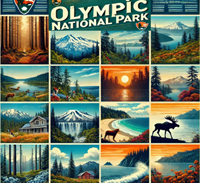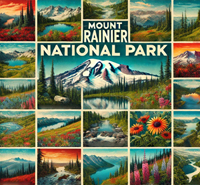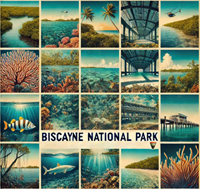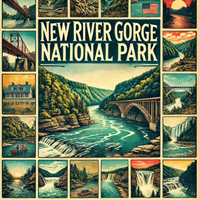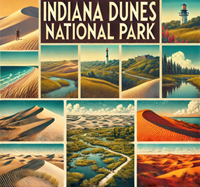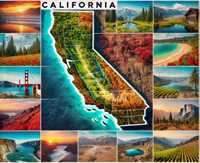

Embark on a journey curated by seasoned explorers William and Hui Cha Stanek, who have spent decades immersing themselves in the diverse landscapes of North America. These itineraries are more than just travel plans - they are thoughtfully crafted adventures designed to help you connect with the natural world, discover hidden gems, and create lasting memories.
National Parks Index | US Itineraries Index | American Roadtrips Index

Bring home a Bugville Critters book and watch as your child's love for reading and learning grows with every page. Hand-painted illustrations bring the heartwarming stories to life. Ask your librarian to add Bugville Critters to the library's digital collection today!
Discover William Stanek's Exclusive Art Collection
Explore and purchase the stunning art featured on this site. Own a piece of William Stanek's unique and captivating artwork today!
(May 2, 2025) Exploring the Southwest: A 5-Day Journey Through Saguaro, White Sands, Carlsbad Caverns, Petrified Forest, and Monument Valley
Introduction: Discovering the Mysteries of the American Southwest
The American Southwest is a region defined by its rugged beauty, where vast deserts, towering cacti, ancient petrified trees, and deep underground caverns tell the story of the Earth's ancient past. This five-day journey will take you through some of the most iconic and awe-inspiring landscapes in the Southwest, from the majestic saguaro forests of Arizona to the otherworldly dunes of White Sands, the subterranean wonders of Carlsbad Caverns, the fossilized forests of Petrified Forest National Park, and the iconic red rock formations of Monument Valley.
Whether you're wandering through towering cacti at sunrise, exploring an underground labyrinth of caverns, or standing in awe beneath the towering spires of Monument Valley, each day promises to be an adventure filled with discovery, inspiration, and unforgettable memories.
Join us as we embark on a journey through the heart of the American Southwest, where every day brings new landscapes, new challenges, and new opportunities to connect with nature in its most raw and beautiful form.
Day 1: Saguaro National Park – Exploring the Giant Cacti of the Sonoran Desert
Morning: Sunrise at the Desert Discovery Nature Trail
Overview
Begin your journey with a sunrise visit to the Desert Discovery Nature Trail in Saguaro National Park's West District (Tucson Mountain District). This short, easy trail offers an introduction to the Sonoran Desert, featuring a variety of desert plants and wildlife. The highlight of the trail is the towering saguaro cacti, some of which are over 200 years old. Watching the sunrise here is a serene and awe-inspiring experience, as the first light of the day illuminates the cacti and creates long, dramatic shadows across the desert floor.
Tips from William
"The Desert Discovery Nature Trail is a great spot for sunrise photography, especially if you're interested in capturing the iconic saguaro cacti. Bring a tripod and a wide-angle lens to capture the full scope of the landscape. A polarizing filter can help enhance the colors of the desert and reduce glare from the sand."
Insights from Hui Cha
"Arriving at the Desert Discovery Nature Trail before dawn allows you to experience the park in its quietest and most serene moments. The stillness of the desert, the cool morning air, and the sight of the sun slowly rising over the cacti create a sense of peace and connection to this ancient landscape."
How to Access the Desert Discovery Nature Trail
Directions:
- The Desert Discovery Nature Trail is located in the Tucson Mountain District of Saguaro National Park, just off Picture Rocks Road. The trail is easily accessible from the main road, with parking available near the trailhead.
Trail Details:
- Location: Saguaro National Park West, AZ
- Trail Length: 0.5 miles round-trip
- Elevation Gain: Minimal
- Difficulty: Easy
Photography Tips: For the best shots along the Desert Discovery Nature Trail, focus on capturing the contrast between the towering saguaro cacti and the surrounding desert. Use a small aperture (f/16 or smaller) to keep the entire scene in focus, and experiment with different compositions to highlight the shapes and silhouettes of the cacti.
Alternative Activity: If the Desert Discovery Nature Trail sounds too short, consider exploring the nearby Valley View Overlook Trail, a 0.8-mile round-trip hike that offers beautiful views of the desert and surrounding mountains.
Mid-Morning: Exploring the Bajada Loop Drive
Overview
After your sunrise experience, take a leisurely drive along the Bajada Loop Drive, a scenic gravel road that winds through the heart of Saguaro National Park's West District. The drive offers stunning views of the saguaro forest, with numerous pullouts where you can stop to take in the scenery, photograph the cacti, and learn more about the desert ecosystem.
Tips from William
"The Bajada Loop Drive offers endless opportunities for landscape photography. Bring a telephoto lens to capture close-up shots of the saguaro cacti and a wide-angle lens for sweeping views of the desert. The best light for photography is in the mid-morning when the sun is high enough to illuminate the landscape but not too harsh."
Insights from Hui Cha
"Driving the Bajada Loop is a journey through one of the most unique and beautiful landscapes in the American Southwest. The sight of the saguaro forest from the road, the sound of the wind in the cacti, and the views of the distant mountains create a sense of wonder and connection to this ancient and resilient ecosystem."
How to Access the Bajada Loop Drive
Directions:
- The Bajada Loop Drive begins near the Red Hills Visitor Center in Saguaro National Park's West District. The loop is well-marked and easy to follow, with several pullouts and overlooks along the way.
Scenic Drive Details:
- Location: Saguaro National Park West, AZ
- Difficulty: Easy (drive with short walks)
Photography Tips: For the best shots along the Bajada Loop Drive, focus on capturing the play of light and shadow on the cacti and desert floor. Use a wide-angle lens to capture the expansive views and a telephoto lens to zoom in on the details of the cacti and surrounding plants.
Alternative Activity: If driving the entire Bajada Loop sounds too long, consider stopping at the Signal Hill Picnic Area, where you can take a short hike to see ancient petroglyphs and enjoy views of the surrounding desert.
Afternoon: Hiking the King Canyon Trail
Overview
In the afternoon, challenge yourself with a hike on the King Canyon Trail, a scenic trail that takes you through the saguaro forest and up to the summit of Wasson Peak, the highest point in Saguaro National Park's West District. The trail offers stunning views of the desert, mountains, and distant Tucson, as well as opportunities to see a variety of desert plants and wildlife.
Tips from William
"The King Canyon Trail is perfect for landscape photography. Bring a wide-angle lens to capture the expansive views of the desert and surrounding mountains, and a telephoto lens for close-up shots of the plants and wildlife along the trail. The best light for photography is in the late afternoon when the sun is low in the sky and the shadows are long."
Insights from Hui Cha
"Hiking the King Canyon Trail is a journey through some of the most beautiful and rugged landscapes in Saguaro National Park. The sight of the towering cacti, the sound of the wind in the desert, and the views of the distant mountains create a sense of awe and connection to the natural world."
How to Access the King Canyon Trail
Directions:
- The King Canyon Trailhead is located near the Arizona-Sonora Desert Museum, just off Kinney Road. The trail is well-marked and includes several scenic viewpoints along the way.
Trail Details:
- Trail Length: 6.5 miles round-trip to Wasson Peak
- Elevation Gain: 1,800 feet
- Difficulty: Strenuous
Photography Tips: For the best shots along the King Canyon Trail, focus on capturing the contrast between the rugged desert terrain and the distant mountains. A tripod can help stabilize your camera for sharp images, especially in the low light under the desert sky.
Alternative Activity: If the hike to Wasson Peak sounds too challenging, consider exploring the shorter Cactus Wren Trail, a 2.5-mile round-trip hike that offers beautiful views of the desert and surrounding mountains with less elevation gain.
Evening: Sunset at Gates Pass
Overview
End your day with a sunset visit to Gates Pass, one of the most popular and scenic viewpoints in Saguaro National Park. The pass offers stunning views of the surrounding desert and mountains, making it a perfect spot to watch the sun set over the Sonoran Desert.
Tips from William
"Gates Pass is a fantastic spot for sunset photography. Bring a wide-angle lens to capture the full scope of the landscape, and consider using a graduated neutral density filter to balance the exposure between the bright sky and the darker land. The best light for photography is in the late evening when the sun is low in the sky and the shadows are long."
Insights from Hui Cha
"Watching the sunset from Gates Pass is a peaceful and inspiring experience. The colors of the sky, the stillness of the desert, and the sound of the wind create a sense of calm and connection to nature. It's a perfect way to end the day."
How to Access Gates Pass
Directions:
- Gates Pass is located along Gates Pass Road, just west of Tucson. The overlook is easily accessible from the road, with a short walk leading to the viewpoint.
Viewpoint Details:
- Location: Saguaro National Park West, AZ
- Elevation Gain: Minimal
- Difficulty: Easy
Photography Tips: For a stunning sunset shot, position yourself on the western side of the pass to capture the last light of the day as it illuminates the desert and surrounding mountains. Use a small aperture (f/16 or smaller) to keep the entire scene in focus, and experiment with different compositions to highlight the layers and textures of the landscape.
Alternative Activity: If watching the sunset from Gates Pass sounds too crowded, consider heading to the nearby Signal Hill Picnic Area, where you can enjoy equally beautiful views of the desert in a more secluded setting.
Day 2: White Sands National Park – The World's Largest Gypsum Dunes
Morning: Sunrise at the Dunes Drive
Overview
Begin your second day with a sunrise visit to the Dunes Drive in White Sands National Park. This scenic 8-mile drive takes you through the heart of the world's largest gypsum dune field, offering stunning views of the white sands and surrounding mountains. Watching the sunrise here is a surreal and awe-inspiring experience, as the first light of the day casts long shadows across the dunes and creates a stark contrast between the white sand and the blue sky.
Tips from William
"The Dunes Drive is a photographer's paradise, especially at sunrise when the light is soft and the shadows are long. Bring a tripod and a wide-angle lens to capture the full scope of the dunes and consider using a polarizing filter to enhance the colors of the sand and sky."
Insights from Hui Cha
"Arriving at White Sands before dawn allows you to experience the park in its most peaceful moments. The stillness of the dunes, the cool morning air, and the sight of the sun slowly illuminating the white sand create a sense of peace and connection to this unique landscape."
How to Access the Dunes Drive
Directions:
- The Dunes Drive begins at the White Sands Visitor Center, located just off US-70 near Alamogordo, New Mexico. The drive is well-marked and easy to follow, with several pullouts and parking areas along the way.
Scenic Drive Details:
- Location: White Sands National Park, NM
- Difficulty: Easy (drive with short walks)
Photography Tips: For the best shots along the Dunes Drive, focus on capturing the play of light and shadow on the dunes. Use a wide-angle lens to capture the expansive views and a telephoto lens to zoom in on the details of the sand patterns and surrounding plants.
Alternative Activity: If driving the entire Dunes Drive sounds too long, consider stopping at the Interdune Boardwalk, a short, accessible trail that offers beautiful views of the dunes and surrounding mountains.
Mid-Morning: Hiking the Alkali Flat Trail
Overview
After your sunrise experience, challenge yourself with a hike on the Alkali Flat Trail, a 5-mile round-trip trail that takes you deep into the heart of the dune field. The trail offers stunning views of the white dunes, distant mountains, and surrounding desert, as well as opportunities to see a variety of desert plants and wildlife.
Tips from William
"The Alkali Flat Trail is perfect for landscape photography. Bring a wide-angle lens to capture the expansive views of the dunes and surrounding mountains, and a telephoto lens for close-up shots of the sand patterns and wildlife along the trail. The best light for photography is in the mid-morning when the sun is high enough to illuminate the landscape but not too harsh."
Insights from Hui Cha
"Hiking the Alkali Flat Trail is a journey through one of the most surreal and beautiful landscapes in the American Southwest. The sight of the endless white dunes, the sound of the wind in the sand, and the views of the distant mountains create a sense of awe and connection to the natural world."
How to Access the Alkali Flat Trail
Directions:
- The Alkali Flat Trailhead is located near the end of the Dunes Drive. The trail is well-marked with orange posts, but hikers should be prepared for soft sand and changing weather conditions.
Trail Details:
- Trail Length: 5 miles round-trip
- Elevation Gain: Minimal
- Difficulty: Strenuous (due to soft sand and exposure)
Photography Tips: For the best shots along the Alkali Flat Trail, focus on capturing the contrast between the white dunes and the surrounding mountains. A tripod can help stabilize your camera for sharp images, especially in the low light under the desert sky.
Alternative Activity: If the hike along Alkali Flat sounds too challenging, consider exploring the shorter Dune Life Nature Trail, a 1-mile loop that offers beautiful views of the dunes and the chance to learn about the desert's unique flora and fauna.
Afternoon: Sledding on the Dunes
Overview
In the afternoon, enjoy a fun and unique experience by sledding down the white dunes at White Sands National Park. Sledding is a popular activity here, and it's a great way to experience the dunes from a different perspective. Sleds can be purchased at the park's visitor center, or you can bring your own.
Tips from William
"Sledding on the dunes is a great opportunity for action photography. Bring a fast lens to capture the movement of the sleds and a wide-angle lens to include the surrounding dunes and sky. The best light for photography is in the afternoon when the sun is high in the sky and the shadows are minimal."
Insights from Hui Cha
"Sledding down the dunes is a fun and exhilarating experience that's perfect for all ages. The sight of the white sand rushing past, the sound of the sleds gliding over the dunes, and the views of the surrounding mountains create a sense of joy and connection to this unique landscape."
How to Access the Sledding Areas
Directions:
- Sledding is allowed throughout the dune field, but the best areas are located along the Dunes Drive. Simply pull over at any open area with large dunes, and start sledding!
Sledding Details:
- Location: White Sands National Park, NM
- Difficulty: Easy (but be prepared for soft sand and exposure)
Photography Tips: For the best sledding shots, focus on capturing the movement of the sleds against the white sand. Use a fast shutter speed to freeze the action, and experiment with different angles to highlight the curves and patterns of the dunes.
Alternative Activity: If sledding sounds too strenuous, consider exploring the Playa Trail, a short, flat walk that offers beautiful views of the desert and the chance to see seasonal pools of water that form after rain.
Evening: Sunset at the Dunes
Overview
End your day with a sunset visit to the dunes, where you can watch as the last light of the day casts long shadows across the white sands and creates a stunning display of colors. The dunes take on a soft, glowing quality as the sun sets, making it a perfect time for photography and quiet reflection.
Tips from William
"The dunes at sunset are a photographer's dream, with soft, golden light and long, dramatic shadows. Bring a tripod and a wide-angle lens to capture the full scene, and consider using a graduated neutral density filter to balance the exposure between the bright sky and the darker dunes."
Insights from Hui Cha
"Watching the sunset at White Sands is a peaceful and awe-inspiring experience. The colors of the sky, the stillness of the dunes, and the sound of the wind create a sense of calm and connection to nature. It's a perfect way to end the day."
How to Access the Sunset Spots
Directions:
- The best spots for sunset photography are located along the Dunes Drive, where you can find large, open dunes with minimal footprints. Simply pull over at any open area and start exploring.
Viewpoint Details:
- Location: White Sands National Park, NM
- Elevation Gain: Minimal
- Difficulty: Easy
Photography Tips: For a stunning sunset shot, position yourself on a high dune to capture the last light of the day as it illuminates the white sands and surrounding mountains. Use a small aperture (f/16 or smaller) to keep the entire scene in focus, and experiment with different compositions to highlight the layers and textures of the dunes.
Alternative Activity: If watching the sunset from the dunes sounds too crowded, consider heading to the nearby San Andres Mountains, where you can enjoy equally beautiful views of the park and surrounding landscape in a more secluded setting.
Day 3: Carlsbad Caverns National Park – Exploring an Underground Wonderland
Morning: Self-Guided Tour of the Big Room
Overview
Begin your third day with a self-guided tour of the Big Room, the largest single cave chamber in North America. This massive underground chamber is filled with stunning formations, including stalactites, stalagmites, and flowstones. The Big Room offers a fascinating and otherworldly experience, as you wander through the cavern and marvel at the natural sculptures that have formed over millions of years.
Tips from William
"The Big Room is perfect for low-light photography. Bring a tripod and a wide-angle lens to capture the full scope of the cavern, and consider using a high ISO setting to compensate for the low light. A flashlight or headlamp can help you focus in the darker areas of the cave."
Insights from Hui Cha
"Exploring the Big Room is a journey through one of the most unique and awe-inspiring landscapes in the world. The sight of the massive formations, the cool, damp air, and the sense of quiet and solitude create a sense of wonder and connection to the Earth's ancient past."
How to Access the Big Room
Directions:
- The Big Room is located deep within Carlsbad Caverns, accessible by elevator or via the Natural Entrance. The self-guided tour begins at the Big Room Trail, a well-marked path that loops around the chamber.
Trail Details:
- Location: Carlsbad Caverns National Park, NM
- Trail Length: 1.25 miles loop
- Elevation Gain: Minimal
- Difficulty: Easy to Moderate (depending on route)
Photography Tips: For the best shots in the Big Room, focus on capturing the dramatic formations and the play of light and shadow on the cavern walls. Use a tripod to stabilize your camera in the low light, and experiment with different compositions to highlight the textures and shapes of the formations.
Alternative Activity: If the Big Room sounds too overwhelming, consider exploring the shorter Natural Entrance Trail, a 1.25-mile trail that descends into the cave and offers beautiful views of the entrance and surrounding formations.
Mid-Morning: Ranger-Guided Tour of King's Palace
Overview
After exploring the Big Room, join a ranger-guided tour of King's Palace, one of the most stunning and beautifully decorated chambers in Carlsbad Caverns. This tour takes you through four ornate chambers filled with delicate formations, offering a deeper understanding of the cave's geology and history.
Tips from William
"King's Palace is perfect for close-up and macro photography. Bring a macro lens to capture the intricate details of the formations, and a tripod to stabilize your camera in the low light. The best shots are often found in the smaller details, so take your time and explore the textures and shapes of the formations."
Insights from Hui Cha
"Exploring King's Palace with a ranger guide is a fascinating and educational experience. The sight of the delicate formations, the sound of the guide's voice echoing in the cavern, and the stories of the cave's history create a sense of connection to the Earth's ancient past."
How to Access King's Palace
Directions:
- The King's Palace tour begins at the Big Room Trail, near the elevator. The tour is well-marked and includes several scenic viewpoints along the way.
Tour Details:
- Tour Length: 1 mile round-trip
- Elevation Gain: Minimal
- Difficulty: Moderate (due to low light and uneven terrain)
Photography Tips: For the best shots in King's Palace, focus on capturing the delicate formations and the play of light and shadow on the cavern walls. Use a tripod to stabilize your camera in the low light, and experiment with different compositions to highlight the textures and shapes of the formations.
Alternative Activity: If the King's Palace tour sounds too strenuous, consider exploring the shorter and less crowded Left Hand Tunnel Tour, a 2-hour lantern-lit tour that offers a more intimate and historical experience of the cave.
Afternoon: Hiking the Guadalupe Ridge Trail
Overview
In the afternoon, stretch your legs with a hike on the Guadalupe Ridge Trail, a scenic trail that offers stunning views of the surrounding desert, mountains, and Carlsbad Caverns. The trail takes you through a variety of landscapes, from rugged desert terrain to forested ridges, with opportunities to see a variety of desert plants and wildlife.
Tips from William
"The Guadalupe Ridge Trail is perfect for landscape photography. Bring a wide-angle lens to capture the expansive views of the desert and surrounding mountains, and a telephoto lens for close-up shots of the plants and wildlife along the trail. The best light for photography is in the late afternoon when the sun is low in the sky and the shadows are long."
Insights from Hui Cha
"Hiking the Guadalupe Ridge Trail is a journey through some of the most beautiful and rugged landscapes in New Mexico. The sight of the vast desert, the sound of the wind in the ridges, and the views of the distant mountains create a sense of awe and connection to the natural world."
How to Access the Guadalupe Ridge Trail
Directions:
- The Guadalupe Ridge Trailhead is located near the entrance to Carlsbad Caverns National Park, just off US-62/180. The trail is well-marked and includes several scenic viewpoints along the way.
Trail Details:
- Trail Length: 3.2 miles round-trip
- Elevation Gain: 500 feet
- Difficulty: Moderate
Photography Tips: For the best shots along the Guadalupe Ridge Trail, focus on capturing the contrast between the rugged desert terrain and the distant mountains. A tripod can help stabilize your camera for sharp images, especially in the low light under the desert sky.
Alternative Activity: If the hike along Guadalupe Ridge sounds too challenging, consider exploring the shorter Chihuahuan Desert Nature Trail, a 1-mile loop that offers beautiful views of the desert and surrounding mountains with less elevation gain.
Evening: Sunset at the Caverns Entrance
Overview
End your day with a sunset visit to the entrance of Carlsbad Caverns, where you can watch as the last light of the day casts warm, golden hues on the surrounding desert and mountains. The entrance to the caverns is a dramatic and awe-inspiring sight, with the dark, yawning opening contrasting against the bright desert sky.
Tips from William
"The entrance to Carlsbad Caverns is a fantastic spot for sunset photography. Bring a wide-angle lens to capture the full scope of the entrance and surrounding desert, and consider using a graduated neutral density filter to balance the exposure between the bright sky and the darker cavern. The best light for photography is in the late evening when the sun is low in the sky and the shadows are long."
Insights from Hui Cha
"Watching the sunset at Carlsbad Caverns is a peaceful and awe-inspiring experience. The colors of the sky, the stillness of the desert, and the sight of the dark cavern entrance create a sense of calm and connection to nature. It's a perfect way to end the day."
How to Access the Caverns Entrance
Directions:
- The entrance to Carlsbad Caverns is located near the visitor center, just off the Big Room Trail. The entrance is easily accessible from the trail, with a short walk leading to the viewpoint.
Viewpoint Details:
- Location: Carlsbad Caverns National Park, NM
- Elevation Gain: Minimal
- Difficulty: Easy
Photography Tips: For a stunning sunset shot, position yourself at the entrance to the caverns to capture the last light of the day as it illuminates the desert and surrounding mountains. Use a small aperture (f/16 or smaller) to keep the entire scene in focus, and experiment with different compositions to highlight the layers and textures of the landscape.
Alternative Activity: If watching the sunset at the caverns entrance sounds too crowded, consider heading to the nearby Rattlesnake Springs, where you can enjoy equally beautiful views of the desert and surrounding mountains in a more secluded setting.
Day 4: Petrified Forest National Park – Exploring an Ancient Landscape
Morning: Sunrise at the Painted Desert Overlook
Overview
Begin your fourth day with a sunrise visit to the Painted Desert Overlook, one of the most stunning viewpoints in Petrified Forest National Park. The overlook offers panoramic views of the Painted Desert, a vast expanse of colorful badlands that stretch across the northern part of the park. Watching the sunrise here is a surreal and awe-inspiring experience, as the first light of the day illuminates the layers of red, orange, and purple sedimentary rock, creating a breathtaking display of color.
Tips from William
"The Painted Desert Overlook is a photographer's dream, especially at sunrise when the light is soft and the colors are most vibrant. Bring a tripod and a wide-angle lens to capture the full scope of the landscape, and consider using a polarizing filter to enhance the colors of the desert and reduce glare from the rock."
Insights from Hui Cha
"Arriving at the Painted Desert before dawn allows you to experience the park in its quietest and most serene moments. The stillness of the desert, the cool morning air, and the sight of the sun slowly illuminating the colorful badlands create a sense of peace and connection to this ancient landscape."
How to Access the Painted Desert Overlook
Directions:
- The Painted Desert Overlook is located along the Painted Desert Rim Trail, just off the Painted Desert Visitor Center. The overlook is easily accessible from the road, with a short walk leading to the viewpoint.
Viewpoint Details:
- Location: Petrified Forest National Park, AZ
- Elevation Gain: Minimal
- Difficulty: Easy
Photography Tips: For the best shots at the Painted Desert Overlook, focus on capturing the contrast between the colorful badlands and the surrounding desert. Use a small aperture (f/16 or smaller) to keep the entire scene in focus, and experiment with different compositions to highlight the layers and textures of the rock formations.
Alternative Activity: If the Painted Desert Overlook sounds too crowded, consider heading to the nearby Tiponi Point, where you can enjoy equally beautiful views of the Painted Desert in a more secluded setting.
Mid-Morning: Hiking the Blue Mesa Trail
Overview
After your sunrise experience, challenge yourself with a hike on the Blue Mesa Trail, a 1-mile loop that takes you deep into the heart of the Painted Desert's badlands. The trail offers stunning views of the colorful rock formations, as well as opportunities to see ancient petrified wood and a variety of desert plants and wildlife.
Tips from William
"The Blue Mesa Trail is perfect for landscape and documentary photography. Bring a wide-angle lens to capture the expansive views of the badlands and surrounding desert, and a telephoto lens for close-up shots of the petrified wood and wildlife along the trail. The best light for photography is in the mid-morning when the sun is high enough to illuminate the landscape but not too harsh."
Insights from Hui Cha
"Hiking the Blue Mesa Trail is a journey through one of the most surreal and beautiful landscapes in the American Southwest. The sight of the colorful badlands, the sound of the wind in the desert, and the views of the ancient petrified wood create a sense of awe and connection to the natural world."
How to Access the Blue Mesa Trail
Directions:
- The Blue Mesa Trailhead is located along the Blue Mesa Loop, just off the park's main road. The trail is well-marked and includes several scenic viewpoints along the way.
Trail Details:
- Trail Length: 1 mile loop
- Elevation Gain: 120 feet
- Difficulty: Moderate
Photography Tips: For the best shots along the Blue Mesa Trail, focus on capturing the contrast between the colorful badlands and the ancient petrified wood. A tripod can help stabilize your camera for sharp images, especially in the low light under the desert sky.
Alternative Activity: If the Blue Mesa Trail sounds too challenging, consider exploring the shorter Crystal Forest Trail, a 0.75-mile loop that offers beautiful views of the petrified wood and surrounding desert with less elevation gain.
Afternoon: Exploring the Petrified Forest
Overview
In the afternoon, spend time exploring the Petrified Forest, a vast area of ancient fossilized trees that have been preserved for over 200 million years. The park offers a variety of trails and viewpoints where you can see the colorful petrified wood, as well as interpretive signs that explain the geology and history of the area.
Tips from William
"The Petrified Forest is perfect for close-up and macro photography. Bring a macro lens to capture the intricate details of the petrified wood, and a tripod to stabilize your camera in the low light. The best shots are often found in the smaller details, so take your time and explore the textures and colors of the fossilized trees."
Insights from Hui Cha
"Exploring the Petrified Forest is a journey through time. The sight of the ancient fossilized trees, the sound of the wind in the desert, and the stories of the Earth's distant past create a sense of connection to the natural world and the history of our planet."
How to Access the Petrified Forest
Directions:
- The Petrified Forest is located throughout the southern part of Petrified Forest National Park, accessible from several trails and viewpoints along the park's main road. The trails are well-marked and include interpretive signs.
Trail Details:
- Location: Petrified Forest National Park, AZ
- Trail Length: Varies (depending on the trail)
- Elevation Gain: Varies (depending on the trail)
- Difficulty: Easy to Moderate
Photography Tips: For the best shots in the Petrified Forest, focus on capturing the details and colors of the petrified wood. Use a macro lens to zoom in on the intricate patterns and textures, and experiment with different compositions to highlight the shapes and colors of the fossilized trees.
Alternative Activity: If exploring the Petrified Forest sounds too overwhelming, consider taking a scenic drive along the park's main road, which offers beautiful views of the petrified wood and surrounding desert from the comfort of your car.
Evening: Sunset at the Tepees
Overview
End your day with a sunset visit to the Tepees, a series of colorful, cone-shaped rock formations located in the southern part of Petrified Forest National Park. The Tepees offer stunning views of the surrounding desert, with layers of red, orange, and purple sedimentary rock that take on a glowing quality as the sun sets.
Tips from William
"The Tepees are a fantastic spot for sunset photography. Bring a wide-angle lens to capture the full scope of the landscape, and consider using a graduated neutral density filter to balance the exposure between the bright sky and the darker land. The best light for photography is in the late evening when the sun is low in the sky and the shadows are long."
Insights from Hui Cha
"Watching the sunset at the Tepees is a peaceful and awe-inspiring experience. The colors of the sky, the stillness of the desert, and the sight of the glowing rock formations create a sense of calm and connection to nature. It's a perfect way to end the day."
How to Access the Tepees
Directions:
- The Tepees are located along the park's main road, about 4 miles south of the Painted Desert Visitor Center. The formations are easily accessible from the road, with several pullouts and parking areas along the way.
Viewpoint Details:
- Location: Petrified Forest National Park, AZ
- Elevation Gain: Minimal
- Difficulty: Easy
Photography Tips: For a stunning sunset shot, position yourself on the western side of the Tepees to capture the last light of the day as it illuminates the colorful rock formations. Use a small aperture (f/16 or smaller) to keep the entire scene in focus, and experiment with different compositions to highlight the layers and textures of the landscape.
Alternative Activity: If watching the sunset at the Tepees sounds too crowded, consider heading to the nearby Puerco Pueblo, where you can enjoy equally beautiful views of the desert and surrounding landscape in a more secluded setting.
Day 5: Monument Valley – The Iconic Landscape of the American West
Morning: Sunrise at the Mittens Overlook
Overview
Begin your final day with a sunrise visit to the Mittens Overlook, one of the most iconic viewpoints in Monument Valley. The overlook offers stunning views of the Mittens, two towering buttes that rise from the desert floor and are silhouetted against the brightening sky. Watching the sunrise here is a surreal and awe-inspiring experience, as the first light of the day casts long shadows across the valley and creates a breathtaking display of color.
Tips from William
"The Mittens Overlook is a photographer's dream, especially at sunrise when the light is soft and the colors are most vibrant. Bring a tripod and a wide-angle lens to capture the full scope of the landscape, and consider using a polarizing filter to enhance the colors of the desert and reduce glare from the sand."
Insights from Hui Cha
"Arriving at Monument Valley before dawn allows you to experience the park in its quietest and most serene moments. The stillness of the desert, the cool morning air, and the sight of the sun slowly illuminating the towering buttes create a sense of peace and connection to this ancient landscape."
How to Access the Mittens Overlook
Directions:
- The Mittens Overlook is located near the Monument Valley Visitor Center, just off US-163 on the Arizona-Utah border. The overlook is easily accessible from the road, with a short walk leading to the viewpoint.
Viewpoint Details:
- Location: Monument Valley, AZ/UT
- Elevation Gain: Minimal
- Difficulty: Easy
Photography Tips: For the best shots at the Mittens Overlook, focus on capturing the contrast between the towering buttes and the surrounding desert. Use a small aperture (f/16 or smaller) to keep the entire scene in focus, and experiment with different compositions to highlight the shapes and silhouettes of the buttes.
Alternative Activity: If the Mittens Overlook sounds too crowded, consider heading to the nearby John Ford Point, where you can enjoy equally beautiful views of Monument Valley in a more secluded setting.
Mid-Morning: Navajo Guided Tour of Monument Valley
Overview
After your sunrise experience, join a Navajo-guided tour of Monument Valley, which offers a deeper understanding of the park's geology, history, and cultural significance. The tour takes you to some of the most iconic and lesser-known sites in the valley, including ancient petroglyphs, natural arches, and secluded viewpoints.
Tips from William
"A Navajo-guided tour is a great opportunity for cultural and documentary photography. Bring a wide-angle lens to capture the expansive views of the valley and a telephoto lens for close-up shots of the petroglyphs and rock formations. The best shots are often found in the smaller details, so take your time and explore the textures and shapes of the landscape."
Insights from Hui Cha
"Exploring Monument Valley with a Navajo guide is a fascinating and educational experience. The sight of the towering buttes, the sound of the guide's voice telling stories of the valley, and the sense of connection to the land and its people create a deeper appreciation for this iconic landscape."
How to Access the Navajo Guided Tours
Directions:
- Navajo-guided tours typically begin at the Monument Valley Visitor Center or nearby lodges. The tours are well-organized and include transportation to and from the various sites in the valley.
Tour Details:
- Tour Length: Varies (depending on the tour)
- Elevation Gain: Varies (depending on the sites)
- Difficulty: Easy to Moderate
Photography Tips: For the best shots during the Navajo-guided tour, focus on capturing the contrast between the rock formations and the surrounding desert. Use a telephoto lens to zoom in on the details of the petroglyphs and other cultural sites, and experiment with different compositions to highlight the shapes and colors of the landscape.
Alternative Activity: If a guided tour sounds too strenuous, consider taking a self-guided drive along the Monument Valley Scenic Drive, which offers beautiful views of the valley's iconic landmarks from the comfort of your car.
Afternoon: Exploring the Valley of the Gods
Overview
In the afternoon, take a scenic drive through the Valley of the Gods, a lesser-known but equally stunning area located just north of Monument Valley. The valley offers a quieter and more secluded experience, with towering rock formations, vast desert plains, and stunning views of the surrounding mesas and buttes.
Tips from William
"The Valley of the Gods is perfect for landscape photography. Bring a wide-angle lens to capture the expansive views of the rock formations and surrounding desert, and a telephoto lens for close-up shots of the plants and wildlife along the drive. The best light for photography is in the late afternoon when the sun is low in the sky and the shadows are long."
Insights from Hui Cha
"Exploring the Valley of the Gods is a peaceful and awe-inspiring experience. The sight of the towering rock formations, the sound of the wind in the desert, and the views of the distant mesas create a sense of connection to the natural world and the history of the American Southwest."
How to Access the Valley of the Gods
Directions:
- The Valley of the Gods is located just off US-163, about 30 miles north of Monument Valley. The scenic drive is a 17-mile loop that winds through the valley and is accessible by most vehicles.
Scenic Drive Details:
- Location: Valley of the Gods, UT
- Difficulty: Easy (drive with short walks)
Photography Tips: For the best shots in the Valley of the Gods, focus on capturing the contrast between the towering rock formations and the surrounding desert. Use a wide-angle lens to capture the expansive views and a telephoto lens to zoom in on the details of the plants and wildlife.
Alternative Activity: If exploring the Valley of the Gods sounds too strenuous, consider visiting the nearby Goosenecks State Park, where you can enjoy equally beautiful views of the San Juan River winding through deep, twisting canyons.
Evening: Sunset at Muley Point
Overview
End your day with a sunset visit to Muley Point, a remote and stunning viewpoint located at the edge of Cedar Mesa. The point offers panoramic views of the Valley of the Gods, Monument Valley, and the distant Colorado River, making it a perfect spot to watch the sun set over the American Southwest.
Tips from William
"Muley Point is a fantastic spot for sunset photography. Bring a wide-angle lens to capture the full scope of the landscape, and consider using a graduated neutral density filter to balance the exposure between the bright sky and the darker land. The best light for photography is in the late evening when the sun is low in the sky and the shadows are long."
Insights from Hui Cha
"Watching the sunset from Muley Point is a peaceful and awe-inspiring experience. The colors of the sky, the stillness of the desert, and the views of the distant mesas and buttes create a sense of calm and connection to nature. It's a perfect way to end your journey through the American Southwest."
How to Access Muley Point
Directions:
- Muley Point is located at the end of Muley Point Road, just off UT-261 on Cedar Mesa. The viewpoint is easily accessible by a short drive from the main road, with parking available near the edge of the mesa.
Viewpoint Details:
- Location: Muley Point, UT
- Elevation Gain: Minimal
- Difficulty: Easy
Photography Tips: For a stunning sunset shot, position yourself at the edge of the mesa to capture the last light of the day as it illuminates the valley and surrounding mesas. Use a small aperture (f/16 or smaller) to keep the entire scene in focus, and experiment with different compositions to highlight the layers and textures of the landscape.
Alternative Activity: If watching the sunset from Muley Point sounds too remote, consider heading to the nearby Mexican Hat Rock, where you can enjoy equally beautiful views of the valley and surrounding landscape in a more accessible setting.
Conclusion: A Personal Reflection
As the sun set on our final day in the Southwest, we stood at the edge of Muley Point, reflecting on the incredible journey we had just completed. From the towering cacti of Saguaro to the white dunes of White Sands, the underground wonders of Carlsbad Caverns, the ancient petrified wood of the Petrified Forest, and the iconic rock formations of Monument Valley, each day had been a reminder of the incredible beauty and diversity of this region's landscapes.
These parks and trails are more than just places to visit – they are places to connect with the land, to find peace and inspiration, and to create memories that will last a lifetime. As we packed up our gear and prepared to leave Monument Valley, I felt a deep sense of gratitude for the time we had spent in these wild, untamed places. They had not only shown us the beauty of the American Southwest but had also brought us closer to each other and to the world around us.
Our journey through Saguaro, White Sands, Carlsbad Caverns, Petrified Forest, and Monument Valley had come to an end, but the experiences we had shared would stay with us forever. And as we drove away from the valley, I knew that we would return, drawn back by the promise of new adventures and the chance to explore even deeper into the heart of the American Southwest.

Step into a world of timeless beauty with our premium, oversized hardcover book - crafted for discerning collectors and anyone who values the power of art. Perfect for your coffee table, it's more than just a book; it's a conversation starter, a window into over 30 years of William's visionary photography.
Your Support Matters
Purchasing artwork from William Stanek's collection not only brings beauty into your life but also helps us continue to share. Thank you for supporting our creative journey!

Support The Lights of Paris by Robert Stanek, William Stanek's pen name! Through vivid historical detail and deeply moving character stories, Robert takes readers on an unforgettable journey through one of history’s most transformative times.


